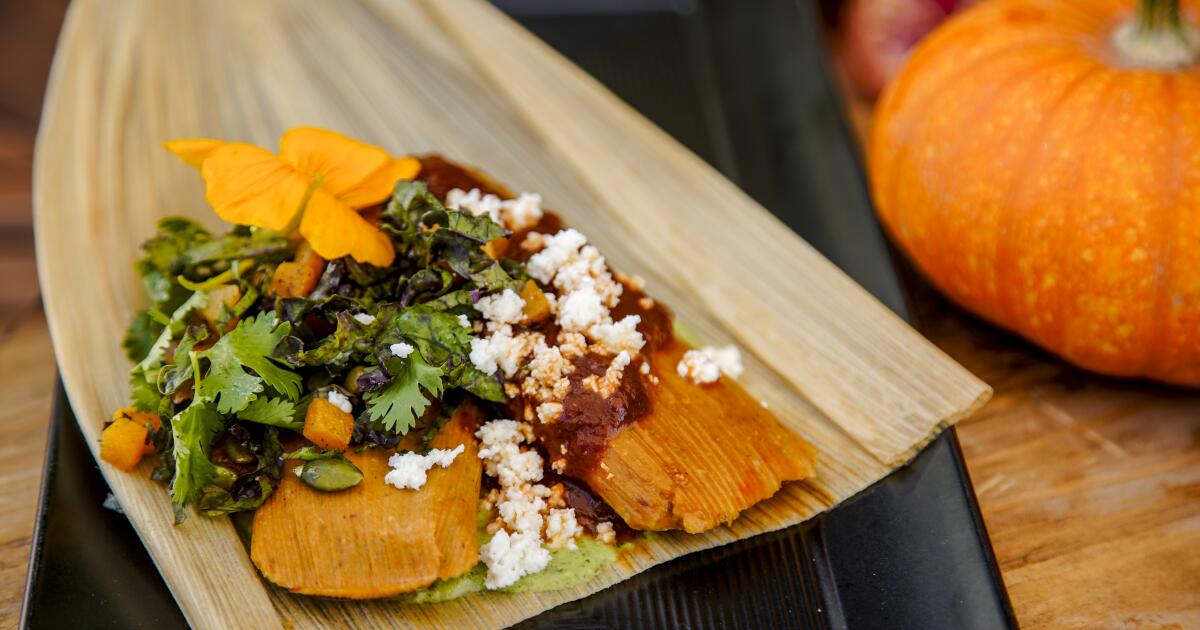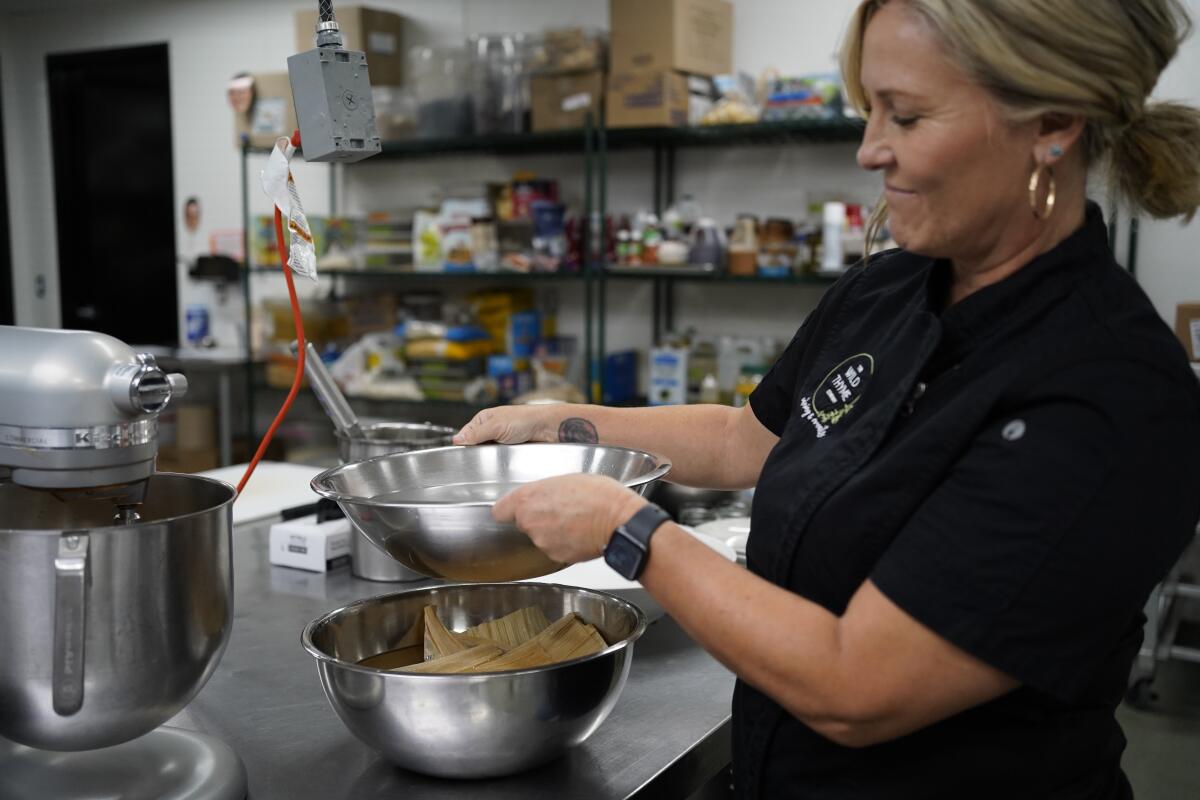
There’s a certain point in time in late August when the afternoon light begins to shift. It’s not as harsh as July light. It softens, gets a little hazy. For some people, it marks the beginning of football season.
For me, it marks a shift in how I eat. I enjoy my last peaches and melons before shifting to apples and figs. And, after initial resistance, I turn my attention fully to the rest of fall’s seasonal ingredients.
That includes winter squash. Is there a vegetable (OK, botanically a fruit) that is more representative of cool-weather comfort food? And there are dozens upon dozens of richly colored varieties to choose from, depending on where you live and where you shop.

Dawn Carvajal, founder and owner of The Wild Thyme Company, said cooking squash to the point of caramelization is a game-changer.
(Alejandro Tamayo / The San Diego Union-Tribune)
Let’s stick with the ones you’ll most likely find at local markets: butternut, honeynut, acorn, delicata, red or green kabocha, kuri, carnival and, of course, pumpkin. All can be steamed, roasted, braised, sauteed or turned into soup. And, while you could eat the skins on any of them, some are just better peeled because the skins are thick or kind of gnarly. These include kuri, kabocha and butternut. Small squash, like honeynut, acorn and delicata, tend to have thinner, more tender skin.
One issue I have struggled with is coaxing unique flavors from winter squash. If you aren’t savvy with your seasonings, squash can seem to have the same one note.
I asked a pair of chefs at The Wild Thyme Company, a longtime catering business, how they amp up winter squash flavors. Dawn Carvajal, the founder and owner, and Cecilia Valencia, the chef de cuisine, offered their perspectives.

Cecilia Valencia, the chef de cuisine for The Wild Thyme Company, said ingredients that grow in the same season, such as leeks, can complement the flavors of squash.
(Alejandro Tamayo / The San Diego Union-Tribune)
Carvajal noted that a lot of people undercook squash — just cooking it until it’s tender.
“But if you keep roasting it to a point of caramelization, you’re going to activate the sugars inside the squash that will make the flavors stand out,” she explained. “I blew myself away when I was making delicata squash one day and put honey butter with sea salt on it while it was cooking. The sweetness of the honey and the richness of the butter with the sea salt was so good, as they all cooked down together with the squash, that I wrote it down to remember to put it on a menu.”
Valencia pointed out the importance of using ingredients that complement the squash, noting the adage that “what grows together goes together.”
“Make sure to use ingredients that are in season,” she said. “Leeks can bring out a little undertone that complements squash and brings out those fall flavors. Same with aromatics like garlic or dark greens like kale that can stand up to the squash. Leafy greens also work, because they don’t hide the squash’s flavor but complement it.
“Also, be mindful of how you apply herbs like sage and rosemary, because they’re so powerful,” Valencia added. “Instead of using fresh sage, consider making a sage brown butter to give it an herbal back note along with the nuttiness of the brown butter.”

Squash, pumpkin and pomegranates can be used in various ways to give the flavors of fall to your meals.
(Alejandro Tamayo / The San Diego Union-Tribune)
Valencia developed three recipes to demonstrate the versatility of winter squash: Chipotle Pumpkin Tamales, Delicata Squash Rings and Kabocha Caprese Salad. Each is easy to prepare and an entirely different way to feature the squash. Plus, each highlights the squash sans pumpkin spice.
Don’t be intimidated by the prospect of making tamales. For one thing, these aren’t filled (although Valencia said you could — and go either savory or sweet). For another, making them is pretty straightforward. While regular masa is fine to use, Valencia prefers tamale masa, which you can find at Latin markets. She adds canned pumpkin puree to the tamale dough, along with chipotle in adobo for heat and a smoky flavor. You can make the dough in advance; just whip it up again in the stand mixer to return its fluffiness.

Masa is spread onto a prepared corn husk.
(Alejandro Tamayo / The San Diego Union-Tribune)

After the corn husk with masa is folded, a second prepared corn husk is added to cover the tamale.
(Alejandro Tamayo / The San Diego Union-Tribune)

The tamales are steamed for about an hour, then the husks removed.
(Alejandro Tamayo / The San Diego Union-Tribune)
The other key to success is how the tamales are wrapped. The corn husks need to be rinsed and then soaked for an hour or two in hot water. Dry each husk thoroughly as you use them. There are two to a tamale to make sure the tamale dough doesn’t spill out. Valencia and Carvajal use offset spatulas to spread the dough into neat vertical rectangles at the bottom of the first husk, then wrapping one side over the dough and the other side over that. Bring what now looks like a tail over the fold to the bottom. Use another corn husk to do the same thing in reverse. Then stack each tamale in a steamer basket loosely so they each cook fully.
Valencia added two salsas to accompany the tamales. Her creamy Tomatillo & Avocado Salsa is the foundation on which she places the unwrapped tamale for serving. She tops it with her Chipotle Salsa.
The Delicata Squash Rings are a twist on a breaded and baked vegetable that you can make with kids. It’s your basic three-dip approach: a bowl of seasoned flour and a second bowl of buttermilk, mustard and eggs. The third brings the crunch: panko, Parmesan cheese, herbs and spices. You’ll dip slices of the squash in each, then bake. Serve with your favorite dipping sauce.
Finally, there’s the Kabocha Caprese Salad. Valencia brings together roasted moons of squash (skin on is fine here) with luscious burrata cheese, roasted golden beets, arugula, grapes and toasted pecans. Use these or switch some of the ingredients for others — like roasted carrots, Brussels sprouts or sweet potatoes. Maybe pears, persimmons or pomegranate seeds. It’s a versatile salad that features the sweetness of kabocha squash.

Chipotle Pumpkin Tamales with Tomatillo & Avocado Salsa and sprinkles of queso fresco.
(Alejandro Tamayo / The San Diego Union-Tribune)
Chipotle Pumpkin Tamales With Two Salsas
Makes 12 to 15 tamales
FOR THE TAMALES:
2½ cups masa flour for tamales
½ teaspoon salt
1 cup vegetable stock
½ cup vegetable shortening (can be substituted with lard)
2½ cups pumpkin puree
¼ cup chipotle in adobo, blended until smooth
24 to 30 corn husks, rinsed, then soaked in a bowl of hot water for at least an hour
FOR SERVING:
Tomatillo & Avocado Salsa (recipe follows)
Chipotle Salsa (recipe follows)
Combine masa flour and salt in the bowl of a stand mixer with a whisk attachment.
In a sauce pot, bring stock to a simmer. Add shortening and stir until melted. Add pumpkin and chipotle. Stir until well incorporated.
Add pumpkin mixture slowly to flour while on low speed. Your dough should be the texture of very wet sand. It shouldn’t be runny. but wet enough that you can spread it easily. Once combined, mix on high for about 5 minutes until dough is fluffy.
Spread approximately ⅓ cup masa onto prepared corn husks in a vertical rectangle starting from the bottom and going up about 3½ inches. Fold one side of the husk over the masa, then the other side. Bring the rest of the husk down and over the wrapped masa. Take a second corn husk and do the same folds in reverse to cover the exposed masa while it steams.
Loosely stack the tamales in a steamer basket, place in pot with enough water to almost reach the bottom of the basket, cover and bring to a boil. Steam for about 1 hour, replacing water if necessary. The tamale should be able to easily pull away from the husk once cooked.
Remove tamale from husk once ready to serve with desired salsas and toppings.

Cecilia Valencia adds Tomatillo & Avocado Salsa to a corn husk while assembling tamales.
(Alejandro Tamayo / The San Diego Union-Tribune)
Tomatillo & Avocado Salsa
Makes 3 cups
3 cups tomatillos, peeled and washed
¼ cup onion, peeled
5 cloves garlic, peeled
2 serrano chiles
2 limes, juiced
1 bunch cilantro
1 avocado
Vegetable oil
Salt and pepper to taste
Puree everything, except for oil, together in a blender.
Slowly stream in oil until desired consistency. Season to taste.
Chipotle Salsa
Makes 1½ cups
2 tablespoons vegetable oil
2 tablespoons all-purpose flour
2 tablespoons chili powder
2 chipotle peppers, in adobo
1 teaspoon garlic powder
1 teaspoon cumin, ground
½ teaspoon dried oregano
2 cups vegetable stock
Salt to taste
Chop the chipotle peppers finely.
Heat vegetable oil in a small pot over medium heat.
Add flour and whisk quickly. Add spices and chipotle, whisking to combine evenly.
Slowly whisk in stock and mix until smooth.
Reduce heat to a simmer, cook for 8 to 10 minutes or until you reach your desired consistency. Taste and adjust seasonings as needed.

Delicata squash takes a dip in flour, an egg mixture, then seasoned panko bread crumbs before baking in the oven for a crunchy ring.
(Alejandro Tamayo / The San Diego Union-Tribune)
Delicata Squash Rings
Makes 4 servings

Preparing the dry and wet mix for the Delicata Squash Rings.
(Alejandro Tamayo / The San Diego Union-Tribune)

Garnishing the Delicata Squash Rings with pomegranate arils and fresh herbs.
(Alejandro Tamayo / The San Diego Union-Tribune)
1 cup all-purpose flour
2 teaspoons salt
1 teaspoon ground pepper
⅓ cup buttermilk
1 tablespoon Dijon mustard
2 eggs
2 cups panko
1 cup Parmesan cheese, grated
2 teaspoons dried basil
1 teaspoon dried oregano
2 teaspoons garlic powder
2 teaspoons onion powder
1 teaspoon paprika
2 pounds delicata squash
Combine flour, salt and pepper in a small bowl.
In a separate bowl, combine buttermilk, mustard and eggs.
In a third bowl, combine the panko, Parmesan cheese, dried herbs and remaining spices.
Cut the top and bottom of the squash so you can scoop out the seeds while keeping the round squash intact. Discard seeds. Slice into ¼-inch-thick rings.
Toss squash rings in flour mixture, shake off excess, then dip into buttermilk mixture. Press rings in panko mixture, making sure to coat the rings evenly.
Bake in a preheated 375-degree oven for 15 to 20 minutes or until squash is baked through and breading is crispy. Flip the rings halfway through the cooking time.
Serve with aioli, or feta ranch. Suggested toppings include pomegranate seeds, or fresh herbs and lemon.

Sweet kabocha squash is paired with burrata, roasted beets and arugula and can be topped with pecans and a sweet fruit.
(Alejandro Tamayo / The San Diego Union-Tribune)
Kabocha Caprese Salad
Makes 1 serving
1 pound kabocha squash
2 teaspoons extra-virgin olive oil
Salt and pepper to taste
4 ounces burrata
¼ cup golden beets, roasted and peeled, diced
1 cup arugula
1 teaspoon lemon zest
2 tablespoons grapes, sliced
1 tablespoon raw pecans, toasted and chopped
FOR SERVING:
1 teaspoon Basil Oil (recipe follows)
Cut the kabocha squash in half, scoop out the seeds.
Slice the squash into half-moons, approximately ¼ inch thick. Toss with 1 teaspoon of oil and salt and pepper.
Mark squash on a preheated grill. Finish cooking in an oven at 350 degrees until the squash is soft. Allow to cool.
To plate, arrange your squash on the bottom of the plate. Break your burrata into 5 to 6 pieces and divide over the squash. Season with salt and pepper. Add diced golden beets to salad.
Toss arugula with lemon zest, the remaining teaspoon of oil, salt and pepper. Spread greens around the plate.
Top salad with grapes and pecans.
Finish with a drizzle of basil oil over salad.
Basil Oil
Makes 1 cup
1 cup fresh basil leaves
½ cup extra-virgin olive oil
Bring 1 quart of water to a boil in a small stock pot. Prepare a bowl with 1 quart of ice water.
Add basil to boiling water, making sure it is fully submerged. After 15 seconds, pull it out and immediately plunge it into the ice water to stop the cooking process.
Squeeze out water from basil.
Blend basil and oil until smooth. Strain oil to remove any solids.
Recipes by Cecilia Valencia.
Golden is a San Diego freelance food writer and blogger.







